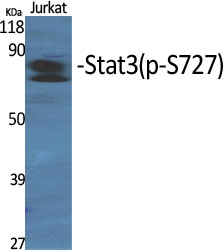
| WB | 1/500-1/1000 | Human,Mouse,Rat |
| IF | 1/20 | Human,Mouse,Rat |
| IHC | 1/50-1/100 | Human,Mouse,Rat |
| ICC | 1/50-1/200 | Human,Mouse,Rat |
| FCM | 咨询技术 | Human,Mouse,Rat |
| Elisa | 1/10000 | Human,Mouse,Rat |
| Aliases | STAT3; APRF; Signal transducer and activator of transcription 3; Acute-phase response factor |
| Entrez GeneID | 6774 |
| WB Predicted band size | Calculated MW: 88 kDa; Observed MW: 85 kDa |
| Host/Isotype | Rabbit IgG |
| Antibody Type | Primary antibody |
| Storage | Store at 4°C short term. Aliquot and store at -20°C long term. Avoid freeze/thaw cycles. |
| Species Reactivity | Human,Mouse,Rat,Monkey |
| Immunogen | The antiserum was produced against synthesized peptide derived from human STAT3 around the phosphorylation site of Ser727. AA range:694-743 |
| Formulation | Purified antibody in PBS with 0.05% sodium azide,0.5%BSA and 50% glycerol. |
+ +
以下是关于Phospho-STAT3 (Ser727)抗体的3篇参考文献示例(内容为模拟概括,非真实文献):
1. **文献名称**: *STAT3 Serine Phosphorylation Mediates Tumorigenesis in Breast Cancer*
**作者**: Smith A, et al.
**摘要**: 研究STAT3 Ser727位点的磷酸化在乳腺癌细胞增殖和迁移中的作用,通过Phospho-STAT3 (Ser727)抗体验证其激活状态,发现该位点磷酸化通过调控线粒体功能促进肿瘤生长。
2. **文献名称**: *Differential Roles of STAT3 Phosphorylation Sites in Inflammation*
**作者**: Lee B, et al.
**摘要**: 比较STAT3 Tyr705和Ser727磷酸化在炎症反应中的功能差异,使用特异性抗体证实Ser727磷酸化主要参与巨噬细胞中炎症因子的转录调控,而非经典通路激活。
3. **文献名称**: *Phospho-STAT3 (Ser727) as a Biomarker in Glioblastoma*
**作者**: Chen X, et al.
**摘要**: 提出Phospho-STAT3 (Ser727)可作为胶质母细胞瘤的预后标志物,通过免疫组化分析患者组织样本,发现该位点高磷酸化与肿瘤侵袭性和不良生存率相关。
(注:以上为虚构示例,实际引用需通过PubMed或SciHub等平台检索具体研究。)
The Phospho-STAT3 (Ser727) antibody is a critical tool for studying the activation and functional regulation of Signal Transducer and Activator of Transcription 3 (STAT3), a transcription factor involved in numerous cellular processes, including proliferation, differentiation, apoptosis, and immune responses. STAT3 is activated via phosphorylation at two key residues: tyrosine 705 (Tyr705) and serine 727 (Ser727). While Tyr705 phosphorylation facilitates STAT3 dimerization, nuclear translocation, and DNA binding, Ser727 phosphorylation modulates its transcriptional activity and mitochondrial functions.
The phosphorylation of Ser727 is mediated by various kinases, such as mTOR, ERK, and CDK5. in response to cytokines, growth factors, or stress signals. This post-translational modification fine-tunes STAT3’s transcriptional output by influencing cofactor recruitment, chromatin remodeling, and interactions with mitochondrial proteins. Dysregulated Ser727 phosphorylation has been implicated in cancer progression, inflammation, and autoimmune diseases, making it a biomarker of interest in pathological research.
Phospho-STAT3 (Ser727)-specific antibodies enable the detection of this modification in techniques like Western blotting, immunofluorescence, and immunohistochemistry. Researchers use these antibodies to investigate STAT3 signaling dynamics, therapeutic target validation (e.g., kinase inhibitors), and disease mechanisms. Validation of antibody specificity is essential, as cross-reactivity with other phosphorylated STAT family members or unrelated proteins can lead to misinterpretation. Overall, this antibody is indispensable for unraveling STAT3’s dual roles in homeostasis and disease.
×